| |
|
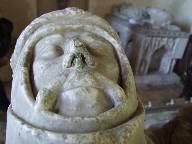 |
|
The border area between
Essex and Suffolk is one of England's
best-kept secrets. Away from touristy
Dedham Vale, the gentle hills rise higher
ever westward beyond the Stour. Here are
East Anglia's prettiest landscapes and
prettiest villages, especially on the
Essex side of the river. Bures has the
best of both worlds, being partly in
Suffolk and partly in Essex, that
much-maligned, lovely county. The Suffolk
part of the village is called Bures St
Mary, because the medieval parish church
is on the Suffolk side of the river. It
has the pubs and the shops. You cross
into Essex and enter Bures Hamlet, part
of the parish of Lamarsh. Here is the
railway station. The war memorial outside
St Mary's church remembers The men of
Bures St Mary and Bures Hamlet who gave
their lives for King and Country in the
Great War, and is perhaps the only
war memorial in England to remember the
dead of not just two separate parishes,
but from two different dioceses in two
separate counties. The gentle river that
separates the two will sprawl out to half
a mile wide before it reaches the sea at
Harwich. |
As historic as St Mary's
church is, there is another building in Bures
which is of at least equal significance, and
which may be of older provenance. St Stephen's
chapel sits on the Suffolk side, above the
village but hidden from it. You leave town on the
road to Assington. After about a mile there
is a farmyard on the right, looking distinctly
unpromising with sheet metal buildings and
concrete hard-standing. A track leads through the
farmyard and then continues for about half a
mile. It doglegs eastwards suddenly, and there,
with just a cottage for company, is this long,
unassuming thatched building.
One
of the stories told about this place is that it
was the site of the coronation of Edmund, one of
the last kings of an independent East Anglia.
Edmund was crowned in AD 855, when he would have
been about 14 years old. The kingdom of East
Anglia and the neighbouring kingdom of Essex were
both already under attack by Viking raiders by
this time, and both would eventually succumb, so
it is not unlikely that the royal palace had been
moved inland from the coast away from Rendlesham,
the previous capital, and Ipswich, by then one of
England's largest towns. However, there seems no
evidence that this was the site of the coronation
other than a 13th Century medieval legend, and
nothing survives to tell of what might have been
here in the 9th Century. By AD 869 Edmund was
dead, slaughtered by Vikings at either Hoxne
(Suffolk) or Hellesdon (Norfolk), depending on
the county to which you owe allegiance. His
remains eventually ended up at Bedricsworth, the
modern Bury St Edmunds, and he was canonised by
the early medieval church as St Edmund. The
shrine at Bury was sacked at the Reformation, and
the remains today are believed to lie in the
crypt of Toulouse Cathedral in south-west France.
As
I say, there is no evidence to show whatever
might or might not have happened here, but
intriguingly, this remote Suffolk field was
considered important enough in 1218 for the
Archbishop of Canterbury, Stephen Langton, to
consecrate this chapel. Canterbury did hold land
in this area, as well as the patronage of the
important nearby parish of Hadleigh, but whatever
the reason for Langton's presence it must have
been significant. At the time, Edmund was
considered the patron Saint of England, a
situation which would change a century later when
Edward III associated St George with the Knights
of the Garter. Edmund's star would set as
George's rose, and the Reformation which
destroyed his shrine would see St Edmund largely
forgotten, but he remains today the patron Saint
of East Anglia and is vigorously championed in
some quarters as the true patron Saint of
England.
The original chapel forms the
easterly two thirds of the building. It was
consecrated on the Feast of St Stephen, December
26th 1218. At the Reformation, the need to blow
apart any devotion to the former King of East
Anglia meant that sites associated with St Edmund
had to be dealt with particularly rigorously. The
chapel was sacked, and once derelict was
converted for use as cottages, and then as a
barn. For the next four hundred years it was used
for agricultural storage. The north wall was
breached to allow access to large farm vehicles,
and later the building was extended westwards.
This extension is still used as a barn.
In the 1930s, the Badcock and
Probert families who owned it restored the
eastern part of the building as a chapel, and it
provided a home for some of the tombs of the De
Veres, the Earls of Oxford, which had previously
been at Colne Priory, just over the border. The
De Veres were the great family of this border
region, their star and boar decorating such great
churches as those of Dedham, East Bergholt,
Castle Hedingham and Lavenham among others,
including Earls Colne itself. They inherited
Colne Priory at the Dissolution, and used the
chapel there as their mausoleum until the early
18th Century. The three tombs here are amalgams
of perhaps eight that were at Earls Colne. Simon
Jenkins thought that the tombs were good enough
for him to include this chapel in his book England's
Thousand Best Churches, and there
is certainly a drama about finding them here in
this lonely spot.
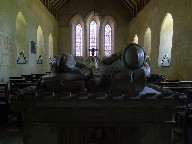
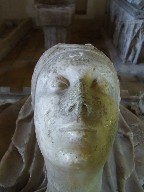 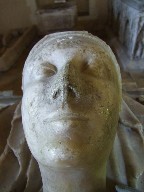
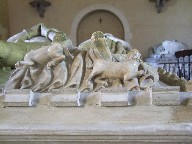
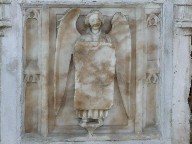 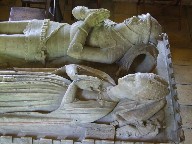
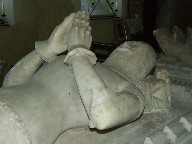 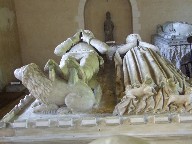
The
impressive effigies of the De Veres are by no
means the only feature of interest here. At the
east end is a good collection of continental
glass of the 16th and 17th Centuries. It includes
two matching figures of St Mary Magdalene and St
Augustine, and a roundel showing the deposition
of Christ's body in the tomb. Of greater interest
still are two medieval panels, one depicting the
scourging of Christ which must once have been
part of a sequence, and another, fragmentary,
which appears to show the Mass of St Gregory, a
late medieval devotion in which the crucified Man
of Sorrows appears on the altar to the future
Pope as he celebrates Mass. This glass may well
all have come from the chapel at Earls Colne.
Three modern figures depict, in the 14th Century
style, St Edmund, St Edward the Confessor and St
Lawrence. Mortlock says they are by Henry
Wilkinson.
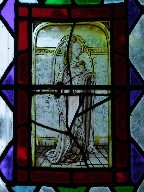
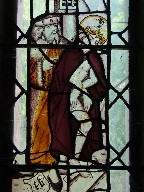 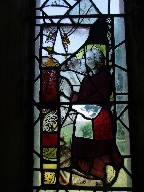 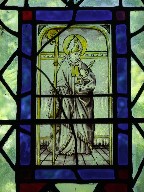
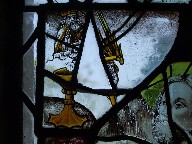 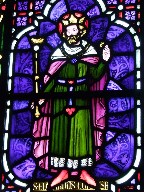 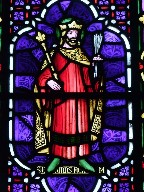 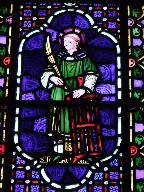 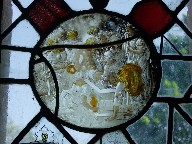
A
transept built on to the north side of the chapel
houses a mezzanine gallery which looks into the
body of the church. At the west end is a
continental statue of a bishop, which was
probably collected in the early 19th Century by
someone. Below it is what appears to be the shaft
of a late medieval font - can it have come from
here originally?
| Also at the west end is a
memorial in the Arts and Crafts style. It
shows an angel surrounded by foliage and
holding a memorial plaque. The
unfortunate effect is of a tortoise
flattened to the wall, but when you get
up close you see it is a memorial to
Isobel Badcock who died loving and
beloved in 1939. It records that she
took great joy in the restoration of this
her chapel and also remembers her
brother-in-law Geoffrey Probert, who
spent long hours here and contributed in
every way he could to make it the
perfect, lovely and worthy offering she
desired. The
narrowness of the building is accentuated
when you stand at the west end and look
eastwards. The massive tombchests give
something of the effect of boats floating
through a tunnel. At the far end, the
triple lancets beckon you to something
beyond them. This is a curious, lovely
place, inevitably unlike any other church
in East Anglia.
|
|
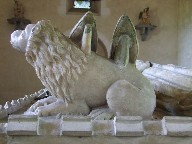 |
|
|
|

